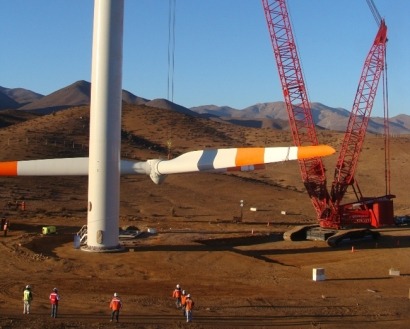
Last month, neighbouring Argentina took receipt of 43 turbine towers for the 160 million-dollar Rawson wind farm, located on Route 1, the road leading to the town of Camarones in the coastal Chibut province.
The Port Authority of Puerto Madryn had worked hard since January to prepare the port terminal to receive the bulky loads related to the Rawson wind energy project, expanding dock space and refurbishing part of its facilities. The 43 Vestas turbine towers arrived mid-May on a Dutch-flagged ship in three segments of different lengths. The considerable investment made to enable the components to be offloaded highlights the importance of developing a local manufacturing base for these bulky parts, which can measure up to 100 metres in height and weigh up to 210 tonnes.
For this reason, the metal transformation company Metallurgical Arrigoni, based in Santiago (Chile), has taken the decision to integrate the ability to fabricate turbine towers into its operations. It has announced plans to build a new facility which, it reveals, will make it the only company able to manufacture wind turbine towers in South America, “aiding to the creation and functioning of new wind farms that are being planned up for the coming years”.
Currently, Chile has more than 4,000 MW of projects that could be built over the next 10 years, and having the capacity to produce these towers would be of great help to the domestic energy market. As CEO of Metallurgical Arrigoni, Dante Arrigoni, says: "Chile urgently needs to increase its electricity generation. Wind power is a real solution to the energy needs we have as a country today”.
The new plant, located in Quilicura on the outskirts of Santiago will meet the highest international manufacturing standards, becoming the most modern plant in Latin America. Metallurgical Arrigoni explains that one of the main features of the plant, its design under its Health, Safety, Environment and Community (HSEC) policy, means that the Quilicura community will be involved in developing and running the plant in order to boost local job prospects and the social development of the commune.
For additional information:

